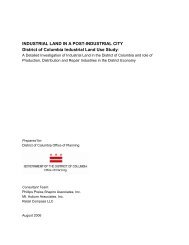An Alternative Future for the North East Mission Industrial Zone
An Alternative Future for the North East Mission Industrial Zone
An Alternative Future for the North East Mission Industrial Zone
Create successful ePaper yourself
Turn your PDF publications into a flip-book with our unique Google optimized e-Paper software.
<strong>An</strong> <strong>Alternative</strong> <strong>Future</strong> <strong>for</strong> <strong>the</strong> NEMIZ<br />
<strong>Mission</strong> Coalition <strong>for</strong> Economic Justice & Jobs<br />
V.4 Policy & Planning Recommendations<br />
cannot be covered by existing rents. PDR incubator buildings in <strong>the</strong> Central<br />
Waterfront and Bayview/Hunter’s Point neighborhoods could be developed with<br />
financial assistance of such an EDC, and support <strong>the</strong> maintenance and creation of<br />
PDR space that is appropriate to each of <strong>the</strong> <strong>East</strong>ern Neighborhoods and <strong>the</strong> Central<br />
Waterfront. According to local brokers, <strong>the</strong> private sector market will not generate<br />
this product, because rents do not support <strong>the</strong> cost of subdividing existing larger<br />
buildings or constructing new buildings <strong>for</strong> <strong>the</strong>se uses, which tend to want small<br />
spaces ranging from about 3,000 to 6,000 square feet, on average. O<strong>the</strong>r financing<br />
mechanisms could be considered, including business improvement districts and/or<br />
neighborhood improvement districts.<br />
E. <strong>An</strong>y IPZ Program Needs to Be Flexible and Include<br />
Monitoring<br />
If <strong>the</strong> City establishes permanent IPZs, <strong>the</strong> program needs to allow <strong>for</strong> flexibility and<br />
monitoring and evaluation with <strong>the</strong> option that an IPZ can be removed if it proves<br />
to be unsuccessful and/or unnecessary.<br />
IPZs can be more effective when <strong>the</strong>y allow <strong>for</strong> flexibility and include mechanisms<br />
<strong>for</strong> removal based on set criteria, which include <strong>the</strong> majority of property owners petitioning<br />
<strong>for</strong> removal. The Chicago program and process seem to be well-planned and<br />
logical in this regard. Of <strong>the</strong> cities reviewed, Chicago's program has been in effect<br />
over <strong>the</strong> longest period of time, and it has established a number of districts. The IPZ<br />
use requirements should be strong enough to support continued industrial / ‘Core’<br />
PDR uses, while being reasonable enough to allow owners to prove that <strong>the</strong>re is no<br />
viable industrial use <strong>for</strong> <strong>the</strong>ir property. Such a flexible program could be tied to o<strong>the</strong>r<br />
economic development tools and programs as recommended above to exhaust all<br />
possible means of creating a viable industrial building or site be<strong>for</strong>e allowing <strong>for</strong> conversion<br />
to o<strong>the</strong>r uses. Should an IPZ prove unsuccessful <strong>for</strong> an area, a simple and<br />
clear process should be outlined <strong>for</strong> its removal, and replacement zoning should be<br />
developed in a reasonable period of time.<br />
Flexibility and monitoring can help to ensure that industrial land is always well-utilized and continues<br />
to generate employment (new FedEx facility in <strong>the</strong> Bayshore).












